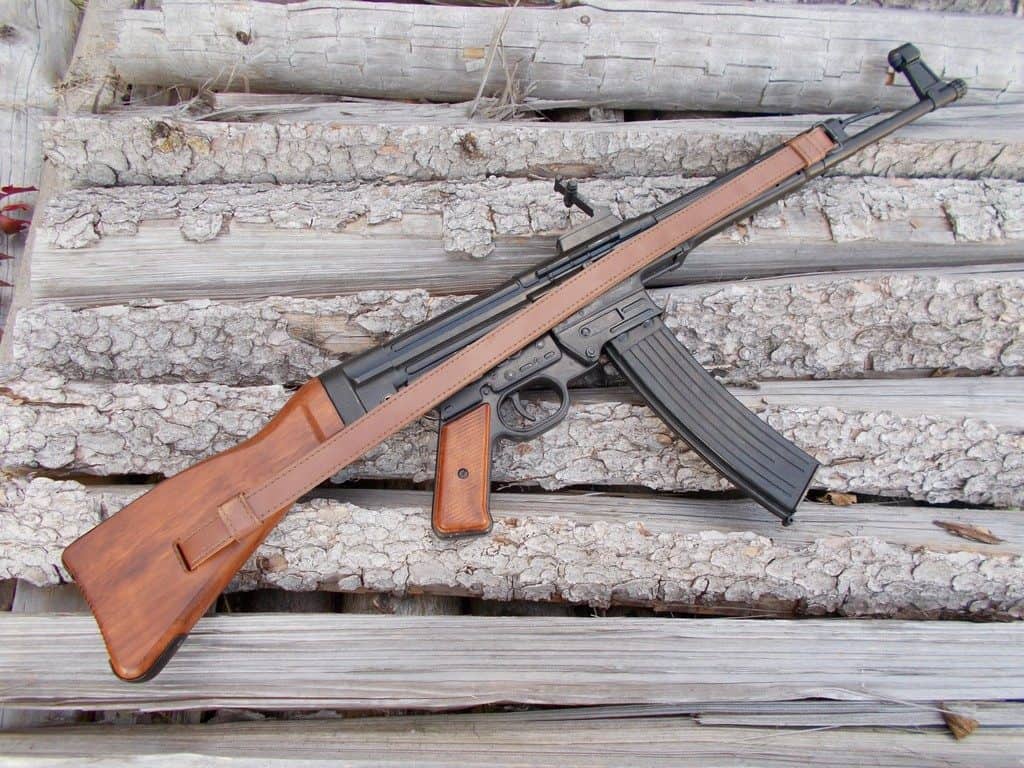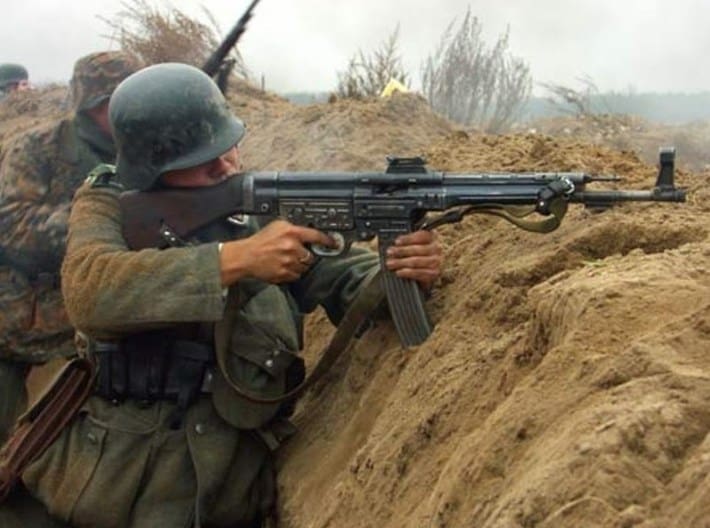The term assault rifle is thrown around with abandon by the media and today’s politicians without an understanding of what it actually means. These kinds of mistakes are highly prevalent with the coverage of mass shootings and can skew the public’s views on firearms in general.
The distinction between semi-automatic weapons and assault rifles is actually quite clear, and the history of the first assault rifle can help inform our perspective on the misunderstood guns.
Read below to learn about the assault rifle, its history, and legacy.

WHAT IS AN ASSAULT RIFLE?
An assault rifle is defined as a military firearm with smaller ammo and firepower, but it has the ability to switch between semi-automatic and fully automatic firing modes. The assault rifles are light and easy-to-use but capable of firing large amounts of rounds at the flip of a switch.
Semi-automatic firing is when you fire one bullet with one pull of the trigger. The automatic part of the name comes from the fact that you don’t have to load the next round yourself. The gun fires, ejects, and loads the next round itself.
Full-auto firing is when multiple bullets are fired from one trigger pull. Assault rifles can fire high volumes of projectiles at an effective range. The US Army says to be considered an assault rifle, the gun must also have a minimum effective range of 300 meters.
Another key part of assault rifles is the ammo size. Traditionally, rifle rounds are long and fairly large. They’re often measured by the size like this: 7.62 x 63 mm. The first number refers to the caliber (or diameter of the bullet); the second number refers to the length of the cartridge.
The higher the caliber the more damage it can do. The longer the cartridge the more propellant there is, the more velocity the bullet has. Assault rifles use shorter-than-normal rifle cartridges to make the recoil less allowing full auto to be more accurate.
Assault rifles are also lighter than other rifles. This is because they use a gas-powered reloading chamber.
As the propellant is released, part of that energy goes to help eject and reload the next round. By using the energy instead of physical moving parts, the rifle is able to be lighter and more portable.
GUNS BEFORE THE FIRST ASSAULT RIFLE
The early 1900s saw a change in how firearms were used in the military. Before, the guns used were largely inaccurate at long distances. Because of this, the fighting style stuck to large spaces and quick forces that overran the enemy.
All of that changed as weapon smiths focused on designing rifles that were more accurate and able to fire quicker. Designers then started to look for ways to load the guns quicker as well. Rather than loading from the front, guns could be loaded from the breach—or rear—of the barrel.
From there, they added a larger amount of bullets into boxes—now called magazines—for even faster reloading. Now the semi-automatic and fully automatic rifle were on the verge of being born.
As the rifles such as the American Springfield 1903 and M-1 Garand rose in popularity, so changed the face of battle. These rifles had long barrels (up to 24 inches long) and fired high caliber ammo. This made these weapons accurate and powerful at long distances.
But the face of closer quarters battles needed to change too. Gunmakers began to look for rifles that could still fire at a decent distance but also be effective in rapid-fire, close quarters situations.
Machine guns are fully automatic weapons that have been around since the 1880s, but they are often heavy and bulky. The gunmakers began to imagine a rifle that combined the accuracy of a rifle and firing speed of a machine gun.
During World War I, Vladimir Grigorevich Fyodorov, a Russian automatic weapons designer, combined the 6.5-mm round of the Japanese Arisaka rifle with full auto firing capability. This was not a true assault rifle yet, but it did indicate the direction gunmakers were moving.
Due to the Russian Revolution in 1917, Fyodorov’s new firearm wasn’t produced at high volume (around 3,200 were made). But gunmakers noticed, and this gun may have been the inspiration for the first true assault rifle.
THE FIRST ASSAULT RIFLE

With World War II in full swing, the tactics of battles continued to change. Soldiers no longer even considered moving in plain sight. Battles were all about position, cover, and support.
As such, the skirmishes where soldiers actually fired on one another happened at medium to close quarters range. While Fyodorov’s new firearm could help with close quarters, armies were looking for something in the middle. They were looking for something with options when it came to combat.
In 1994, it was with this in mind that German gunsmith, Hugo Schmeisser, designed the first assault rifle: the Sturmgewehr 44 (StG 44). Also known as the MP43 or MP44, the assault rifle fired 7.92 mm caliber rounds.
It’s said that Adolph Hitler believed this weapon could change the course of the war. He refused to call it by the MP designation (which stands for machine pistol) but insisted on its more common name, Sturmgewehr. This translates into “assault/storm rifle” which is where the term comes from.
The 7.92 mm caliber was common in the German army at the time. The Mauser rifle used this, but the Sturmgewehr’s version was a shorter cartridge.
With a shorter cartridge, there’s less propellant meaning that the overall speed of the bullet is less. These shorter rounds were much lighter and made the guns much easier to carry and use over the long periods of time that soldiers would be out.
On top of this, the short 7.92 mm cartridges had less recoil. This made the shots accurate at hundreds of meters even while firing on automatic.
Schmeisser also introduced the capacity of selective fire to the weapon. Soldiers could now select whether they fired semi-automatic or on full-auto. This lets them switch tactics depending on the situation they found themselves in.
Schmeisser added the curved box magazine holding 30 rounds to the StG 44. With a shorter barrel, this light gun could fire up to 600 bullets a minute.
This gun made a difference towards the end of the war for the German army, but it was too little too late. The tide had already begun to turn when the StG 44 was distributed.
LEGACY OF THE STG 44
Though the StG 44 wasn’t enough to win the war for the Germans, it made enough of an impression on the world that inspired a legacy that stretches all the way into today. After the end of World War II, other nations scrambled to develop their own versions of the German assault rifle.
RUSSIA/ SOVIET UNION AK-47
Two years after the end of the war Russia revealed their take on the assault rifle, and the AK-47 was born. In 1947, Mikhail Timofeyevich Kalashnikov’s design was adopted by the Russian army. The AK-47 (AK standing for Avtomat Kalashnikova or “automatic Kalashnikov”) used the 7.62 mm caliber rounds.
As the new standard, it also came with the selector switch that is now a defining characteristic of assault rifles. The switch made it simple to go from semi-automatic to full auto like with the StG 44.
Made of forged and milled steel, the AK-47 was lightweight and carried a 30-round magazine similar to the StG 44. It’s this Russian assault rifle that has become the most popular over time. The AK-47 has gone through some changes over the years but has stayed the same at its core.
Taking into account all of its variations, over 100 million AKs have been made. This makes it the single most produced firearm in the history of guns.
AMERICAN/WESTERN M14 RIFLE
After the war ended, the Western nations started to produce their own versions of the Sturmgewehr 44. The British started with the EM-2 and used an tiny cartridge for their .280 caliber ammo.
The United States didn’t want to change things so fast. Coming off the experience of many nations working together (the Allied Nations), the US learned the importance of a standard ammo size. This way ammo and weapons could be shared between forces without issue.
For this reason, the US pressured NATO (Britain in particular) to an intermediate version of the common 7.62 x 63 mm. This new standard would come in at 7.62 x 51 mm.
In the 1950s, the US got around to developing their own assault rifles. They took the popular M1 rifle and used the new, shorter rounds, added selective semi and full auto modes, and a 20 round detachable magazine. This new weapon was called the M14.
With the larger rounds, the M14 still had a strong recoil with more punch to it. Because of this and its heavier weight, it didn’t take off as a close quarters weapon they way the AK-47 or the StG 44 did.
AR-15 ASSAULT RIFLE

American soldiers weren’t happy with the weight and recoil of the M14, so gun makers toyed around with lighter 5.56 mm (.22-inch) rounds. These much smaller cartridges could be fired at high velocity and volume with minimal recoil.
With this caliber, they chose to use the new AR-15 made by the ArmaLite Division and designed by Eugene M. Stoner. The gas-powered chamber allowed for a lighter gun with reload time.
Fun Fact: The “AR” in AR-15 stands for ArmaLite Rifle, NOT “assault rifle.”
Though this version didn’t take off right away, the design was later sold to Colt. Later, it was rebirthed as the M16. Military and public versions were later sold again as the AR-15.
COMMONLY ASKED QUESTIONS
Does the military use the full auto feature anymore? – Not very often. The armed forces learned that using this too much wastes a lot of money and ammo. The more common selections for military firearms are now the semi-auto and 3-shot burst.
Special operations forces may have the most common use of the full auto feature. When a team needs to lay down cover fire to help get out of a situation, full auto is the safest way to convince the enemy to keep their heads down while the good guys retreat.
Why do gun owners insist that the AR-15 is not an assault rifle despite having “AR” in its name? – This question was addressed above, but it’s so common that it bears repeating. The “AR” in AR-15 stands for ArmaLite Rifles. ArmaLite is the company that designed the gun.
While AR-15s and AK-47s have been used historically as assault rifles, the modern-day civilian use of these doesn’t qualify under this definition. Publicly sold models do not have the ability to be set for fully automatic fire.
Fully auto versions of these do exist, but they aren’t prevalent in the use of crime. In fact, according to the New York Times, 80% of gun crimes occur with common handguns.
How easy is it to buy an assault rifle? – Actually, not easy at all. Since the National Firearms Act in 1934, guns that fire multiple bullets “by the single function of a trigger” are all heavily regulated. In order to actually buy a functional assault rifle, you’ll need to do some of the following:
- Pay over $14,000 to buy
- Live in a state where it’s legal
- Submit to a full Federal background check
- Wait at least six months for paperwork
- Agree to severe restrictions on transportation and use
CONCLUSION
The history of the first assault rifle is a fascinating chapter in the legacy of firearms. Not many guns have the history and impact the Sturgewehr did. From this single change in gun design, the AK-47, M14, and M16 were born.
We hope you enjoyed learning more about this misunderstood firearm. The history of firearms is a fascinating thing that follows the arc of human history.
Now that you know more, you can share this article and information to better inform your friends and those you meet about the truth of assault rifles. From its use in World War II to today’s mislabeling, the assault rifle has been an important part of our life.
If you enjoyed this article you’ll probably like these:


